wheel HONDA PRELUDE 1998 Owners Manual
[x] Cancel search | Manufacturer: HONDA, Model Year: 1998, Model line: PRELUDE, Model: HONDA PRELUDE 1998Pages: 278, PDF Size: 2.61 MB
Page 4 of 278
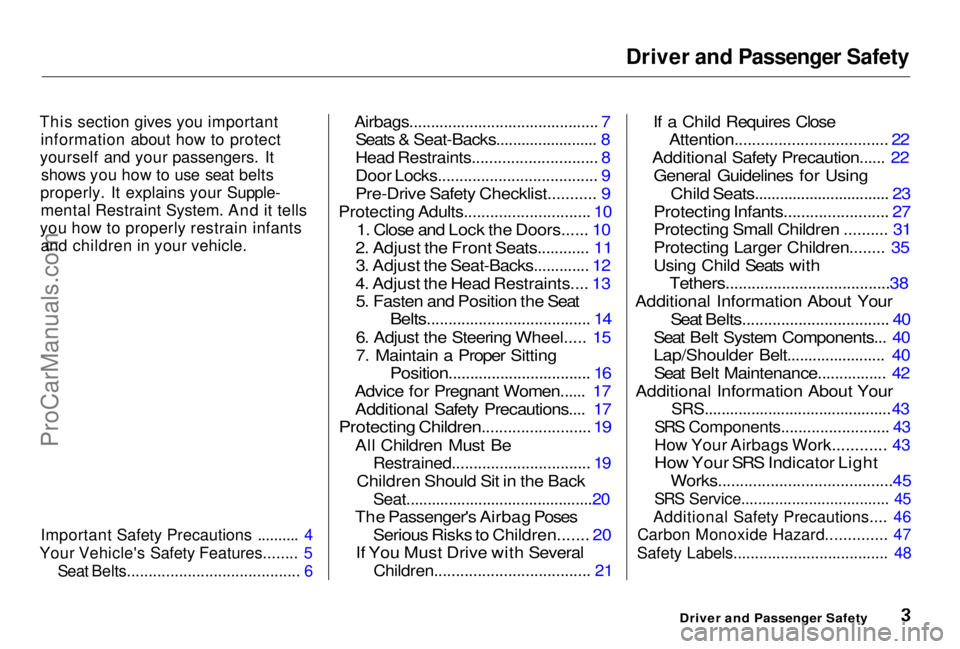
Driver and Passenger Safety
This section gives you important information about how to protect
yourself and your passengers. It shows you how to use seat belts
properly. It explains your Supple- mental Restraint System. And it tells
you how to properly restrain infants and children in your vehicle.
Important Safety Precautions .......... 4
Your Vehicle's Safety Features........ 5 Seat Belts........................................ 6
Airbags............................................ 7
Seats & Seat-Backs........................ 8
Head Restraints............................. 8
Door Locks..................................... 9
Pre-Drive Safety Checklist........... 9
Protecting Adults............................. 10
1. Close and Lock the Doors...... 10
2. Adjust the Front Seats............ 11 3. Adjust the Seat-Backs............. 12
4. Adjust the Head Restraints.... 13 5. Fasten and Position the Seat
Belts...................................... 14
6. Adjust the Steering Wheel..... 15
7. Maintain a Proper Sitting
Position................................. 16
Advice for Pregnant Women...... 17 Additional Safety Precautions.... 17
Protecting Children.........................
19
All Children
Must Be
Restrained................................ 19
Children Should Sit in the Back
Seat............................................20
The Passenger's Airbag Poses
Serious Risks to Children....... 20
If You Must Drive with Several
Children.................................... 21
If a Child Requires Close
Attention................................... 22
Additional Safety Precaution...... 22 General Guidelines for Using
Child Seats................................ 23
Protecting Infants........................ 27
Protecting Small Children .......... 31
Protecting Larger Children........ 35
Using Child Seats with
Tethers......................................38
Additional Information About Your
Seat Belts.................................. 40
Seat Belt System Components... 40
Lap/Shoulder Belt....................... 40 Seat Belt Maintenance................ 42
Additional Information About Your
SRS............................................
43
SRS Components........................ .
43
How Your Airbags Work............ 43
How Your SRS Indicator Light
Works........................................45
SRS Service................................... 45
Additional Safety Precautions.... 46
Carbon Monoxide Hazard.............. 47
Safety Labels.................................... 48
Driver and Passenger SafetyProCarManuals.comMain Menu s t
Page 8 of 278
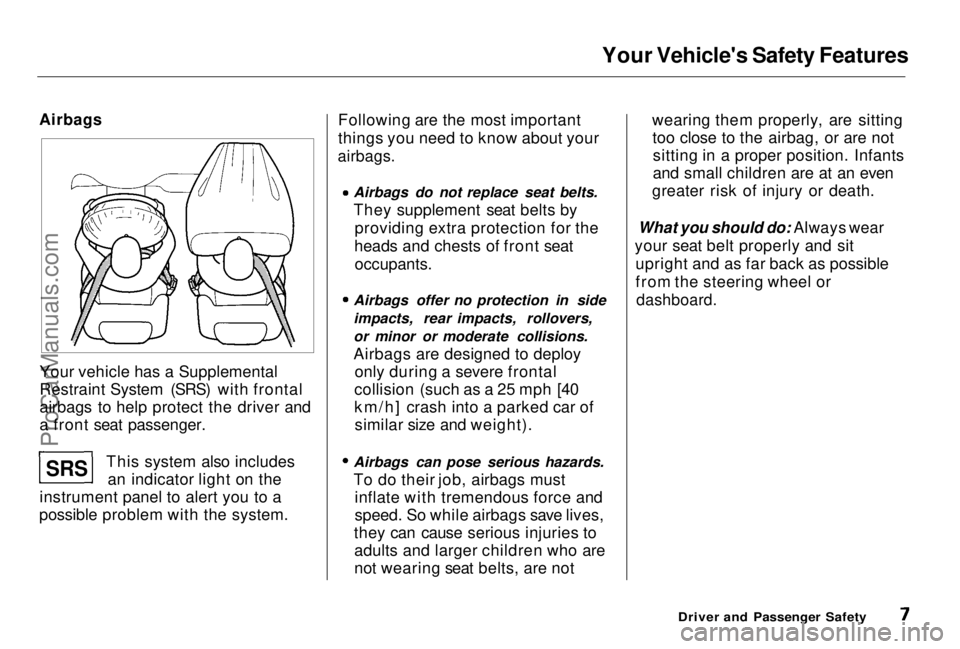
Your Vehicle's Safety Features
Airbags
Your vehicle has a Supplemental
Restraint System (SRS) with frontal
airbags to help protect the driver and
a front seat passenger. This system also includesan indicator light on the
instrument panel to alert you to a
possible problem with the system. Following are the most important
things you need to know about your
airbags.
Airbags do not replace seat belts.
They supplement seat belts byproviding extra protection for the
heads and chests of front seat
occupants.
Airbags offer no protection in side
impacts, rear impacts, rollovers,
or minor or moderate collisions.
Airbags are designed to deploy
only during a severe frontal
collision (such as a 25 mph [40
km/h] crash into a parked car of similar size and weight). Airbags can pose serious hazards.
To do their job, airbags must
inflate with tremendous force and
speed. So while airbags save lives,
they can cause serious injuries to adults and larger children who are
not wearing seat belts, are not wearing them properly, are sitting
too close to the airbag, or are notsitting in a proper position. Infants
and small children are at an even
greater risk of injury or death.
What you should do: Always wear
your seat belt properly and sit upright and as far back as possible
from the steering wheel or
dashboard.
Driver and Passenger Safety
SRS
ProCarManuals.comMain Menu Table of Contents s t
Page 9 of 278

Your Vehicle's Safety Features
Seats & Seat-Backs
Your vehicle seats are designed to
keep you in a comfortable, upright
position so you can take full
advantage of the protection offered
by seat belts and the seats' energy absorbing materials.
How you adjust your seats and seat-
backs can also affect your safety. For
example, sitting too close to the
steering wheel or dashboard
increases your risk of being injured
by striking the inside of the vehicle or being injured by an inflating
airbag.
Reclining a seat-back too far makes
your seat belt less effective and
increases your chance of sliding
under the seat belt and being seriously injured in a crash.
What you should do: Move the front
seats as far back as possible, and
keep adjustable seat-backs in an upright position whenever the
vehicle is moving.
Head Restraints
Head restraints can help protect you
from whiplash and other injuries. For maximum protection, the back of
your head should rest against the center of the head restraint.
Driver and Passenger SafetyProCarManuals.comMain Menu Table of Contents s t
Page 10 of 278
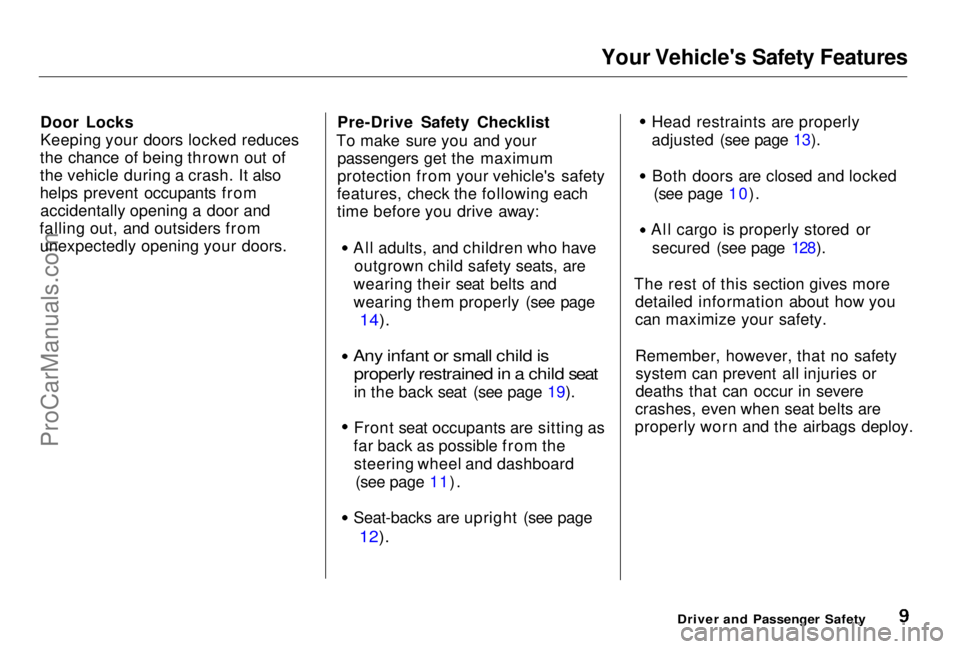
Your Vehicle's Safety Features
Door Locks
Keeping your doors locked reduces
the chance of being thrown out of
the vehicle during a crash. It also
helps prevent occupants from accidentally opening a door and
falling out, and outsiders from unexpectedly opening your doors. Pre-Drive Safety Checklist
To make sure you and your passengers get the maximum
protection from your vehicle's safety
features, check the following each
time before you drive away:
All adults, and children who haveoutgrown child safety seats, are
wearing their seat belts and
wearing them properly (see page
14).
Any infant or small child is properly restrained in a child seat
in the back seat (see page 19). Front seat occupants are sitting as
far back as possible from the steering wheel and dashboard (see page 11).
Seat-backs are upright (see page
12).
Head restraints are properly
adjusted (see page 13). Both doors are closed and locked
(see page 10). All cargo is properly stored or
secured (see page 128).
The rest of this section gives more detailed information about how you
can maximize your safety.
Remember, however, that no safetysystem can prevent all injuries or
deaths that can occur in severe
crashes, even when seat belts are
properly worn and the airbags deploy.
Driver and Passenger SafetyProCarManuals.comMain Menu Table of Contents s t
Page 12 of 278
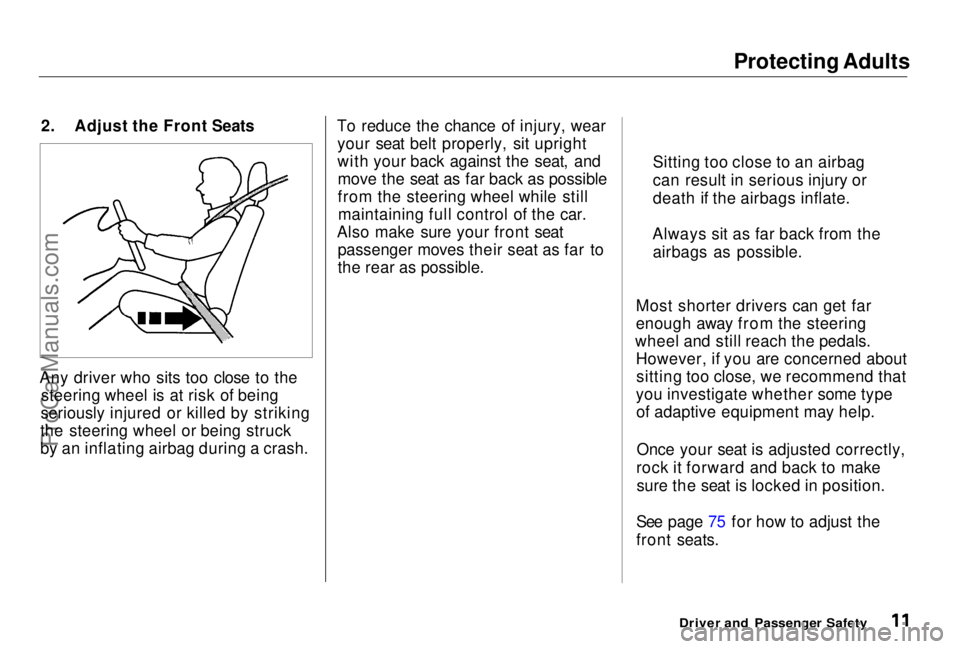
Protecting Adults
2. Adjust the Front Seats
Any driver who sits too close to the steering wheel is at risk of being
seriously injured or killed by striking
the steering wheel or being struck
by an inflating airbag during a crash. To reduce the chance of injury, wear
your seat belt properly, sit upright
with your back against the seat, andmove the seat as far back as possible
from the steering wheel while stillmaintaining full control of the car.
Also make sure your front seat passenger moves their seat as far to
the rear as possible.
Most shorter drivers can get far
enough away from the steering
wheel and still reach the pedals. However, if you are concerned aboutsitting too close, we recommend that
you investigate whether some type of adaptive equipment may help.
Once your seat is adjusted correctly,
rock it forward and back to make sure the seat is locked in position.
See page 75 for how to adjust the
front seats.
Driver and Passenger Safety
Sitting too close to an airbag
can result in serious injury or
death if the airbags inflate.
Always sit as far back from the airbags as possible.ProCarManuals.comMain Menu Table of Contents s t
Page 13 of 278
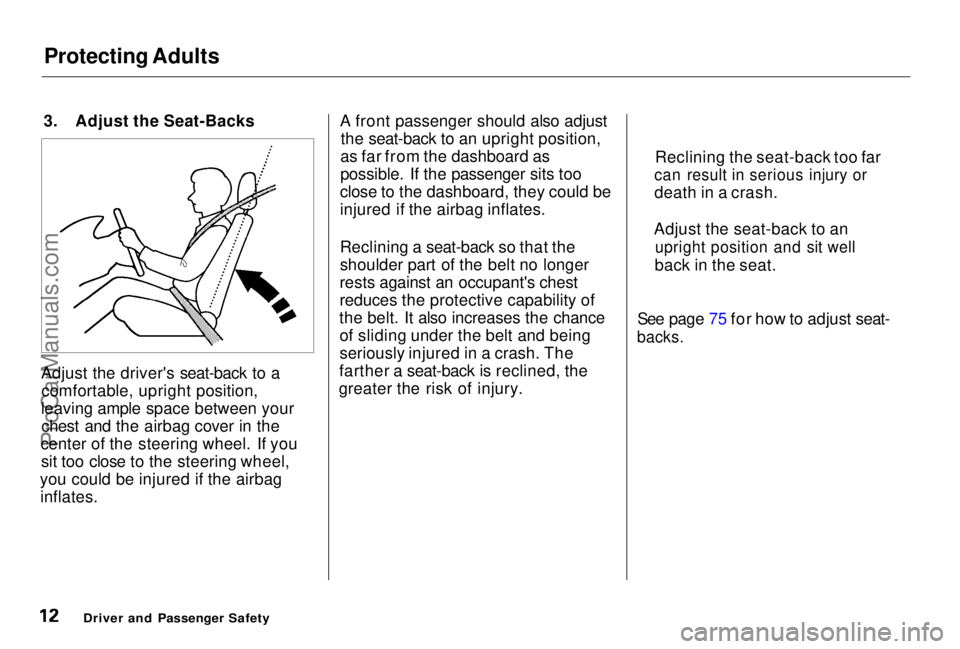
Protecting Adults
3. Adjust the Seat-Backs
Adjust the driver's seat-back to a comfortable, upright position,
leaving ample space between your chest and the airbag cover in the
center of the steering wheel. If you sit too close to the steering wheel,
you could be injured if the airbag inflates. A front passenger should also adjust
the seat-back to an upright position,
as far from the dashboard as
possible. If the passenger sits too
close to the dashboard, they could be
injured if the airbag inflates.
Reclining a seat-back so that the
shoulder part of the belt no longer
rests against an occupant's chest
reduces the protective capability of
the belt. It also increases the chance of sliding under the belt and being
seriously injured in a crash. The
farther a seat-back is reclined, the
greater the risk of injury. See page 75 for how to adjust seat-
backs.
Driver and Passenger Safety
Reclining the seat-back too far
can result in serious injury or
death in a crash.
Adjust the seat-back to an
upright position and sit well
back in the seat.ProCarManuals.comMain Menu Table of Contents s t
Page 16 of 278
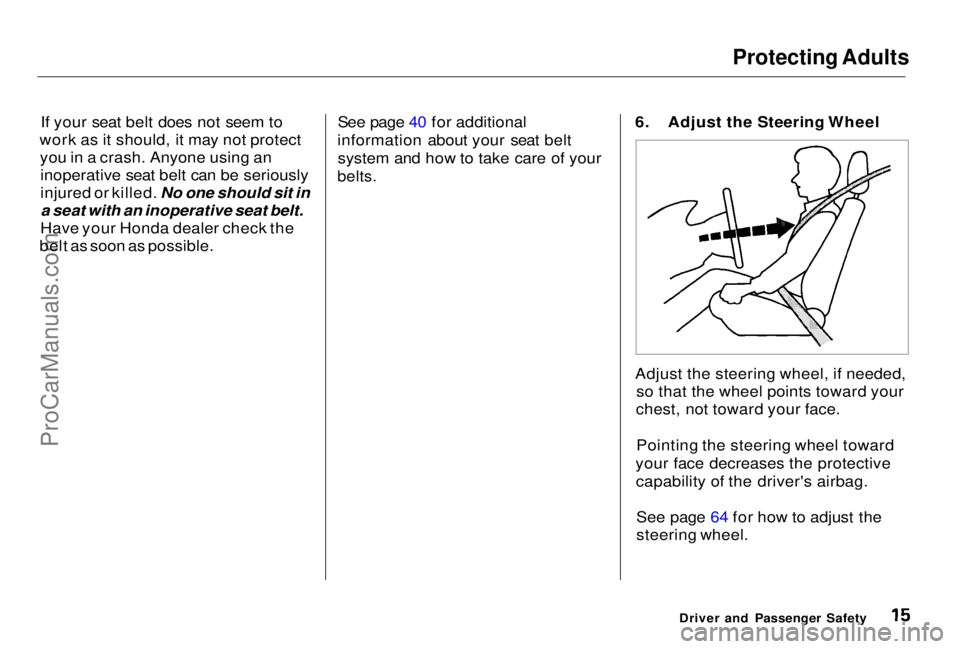
Protecting Adults
If your seat belt does not seem to
work as it should, it may not protect you in a crash. Anyone using aninoperative seat belt can be seriously
injured or killed. No one should sit in
a seat with an inoperative seat belt.
Have your Honda dealer check the
belt as soon as possible. See page 40 for additional
information about your seat belt system and how to take care of your
belts.
6. Adjust the Steering Wheel
Adjust the steering wheel, if needed,
so that the wheel points toward your
chest, not toward your face.
Pointing the steering wheel toward
your face decreases the protective capability of the driver's airbag.
See page 64 for how to adjust the
steering wheel.
Driver and Passenger SafetyProCarManuals.comMain Menu Table of Contents s t
Page 18 of 278
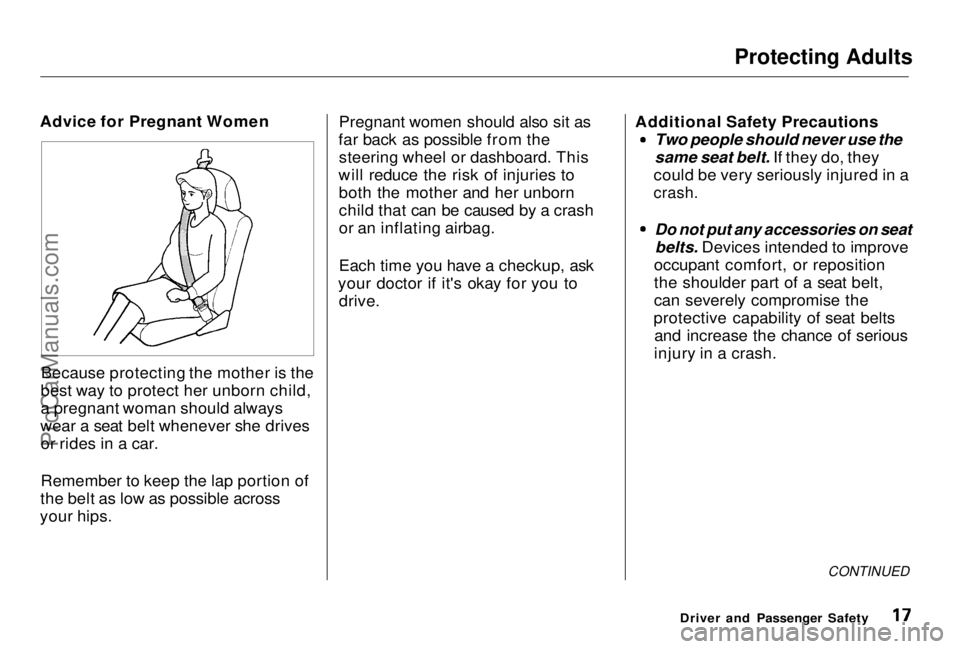
Protecting Adults
Advice for Pregnant Women
Because protecting the mother is the
best way to protect her unborn child,
a pregnant woman should always
wear a seat belt whenever she drives or rides in a car.
Remember to keep the lap portion of
the belt as low as possible across
your hips. Pregnant women should also sit as
far back as possible from the steering wheel or dashboard. This
will reduce the risk of injuries to both the mother and her unborn
child that can be caused by a crash
or an inflating airbag.
Each time you have a checkup, ask
your doctor if it's okay for you to drive. Additional Safety Precautions
Two people should never use the
same seat belt. If they do, they
could be very seriously injured in a
crash.
Do not put any accessories on seat
belts. Devices intended to improve
occupant comfort, or reposition
the shoulder part of a seat belt,
can severely compromise the
protective capability of seat belts and increase the chance of serious
injury in a crash.
CONTINUED
Driver and Passenger SafetyProCarManuals.comMain Menu Table of Contents s t
Page 19 of 278

Protecting Adults
Do not place hard or sharp objects
between yourself and an airbag.
Carrying hard or sharp objects on
your lap, or driving with a pipe or other sharp object in your mouth,
can result in injuries if your
airbags inflate.
Keep your hands and arms away
from the airbag covers. If your
hands or arms are close to the SRS
covers in the center of the
steering wheel and on top of the
dashboard, they could be injured if
the airbags inflate.
Driver and Passenger SafetyProCarManuals.comMain Menu Table of Contents s t
Page 44 of 278

Additional Information About Your SRS
SRS Components
Your Supplemental Restraint System (SRS) includes:
Two frontal airbags. The driver'sairbag is stored in the center of
the steering wheel; the front
passenger's airbag is stored in the dashboard. Both are marked
"SRS".
Sensors that can detect a severe
frontal collision. A sophisticated electronic system
that continually monitors thesensors, control unit, the airbag
activators, and all related wiring
when the ignition is ON (II). An indicator light on the
instrument panel to alert you to a
possible problem with the system (see page 45). Emergency backup power in case
your vehicle's electrical system is disconnected in a crash. How Your Airbags Work
If you ever have a severe frontal
collision, the sensors will detect
rapid deceleration and signal the
control unit to instantly inflate the
airbags.
During a crash, your seat belt helps
restrain your lower body and torso.
Your airbag provides a cushion to help restrain and protect your headand chest.
Driver and Passenger Safety
CONTINUEDProCarManuals.comMain Menu Table of Contents s t